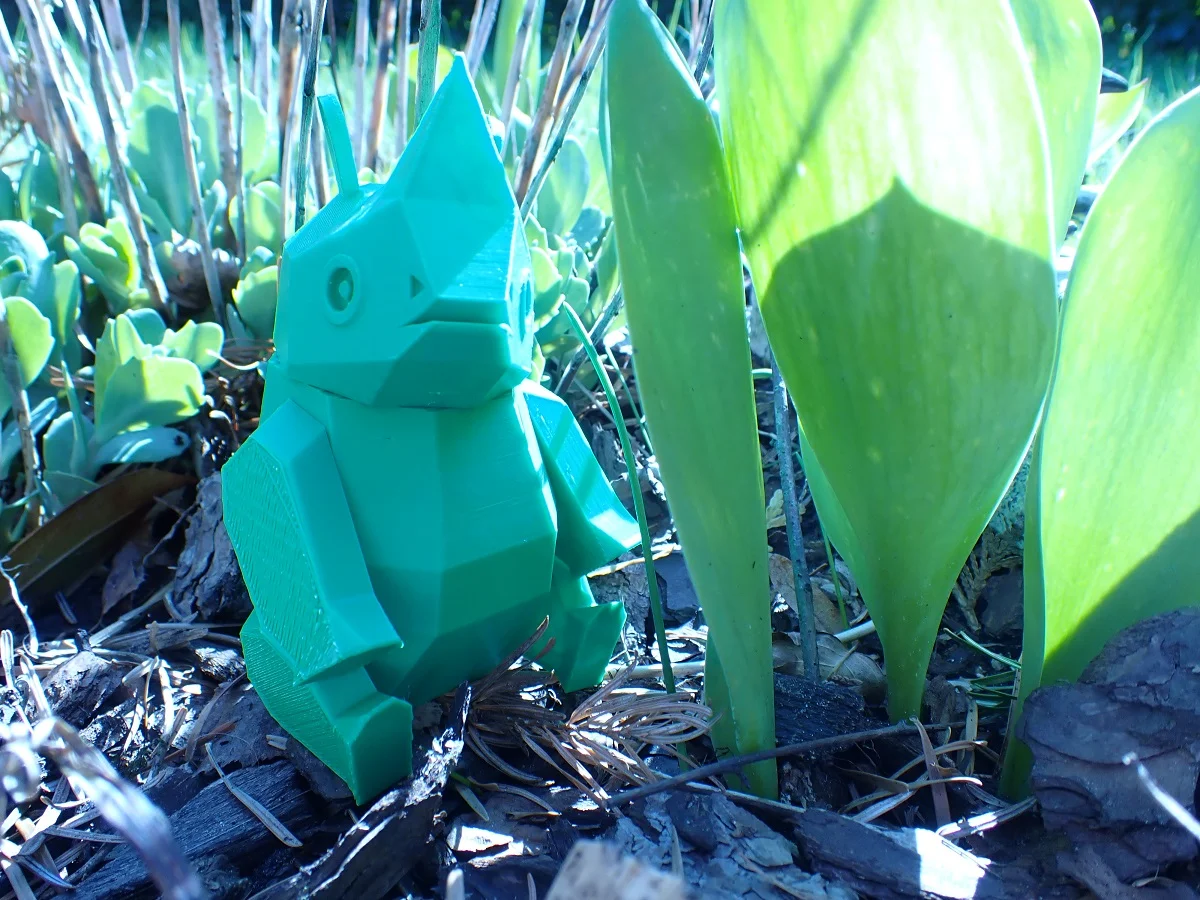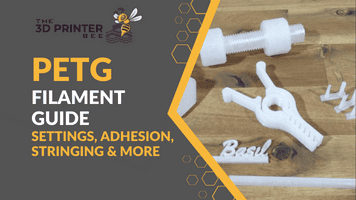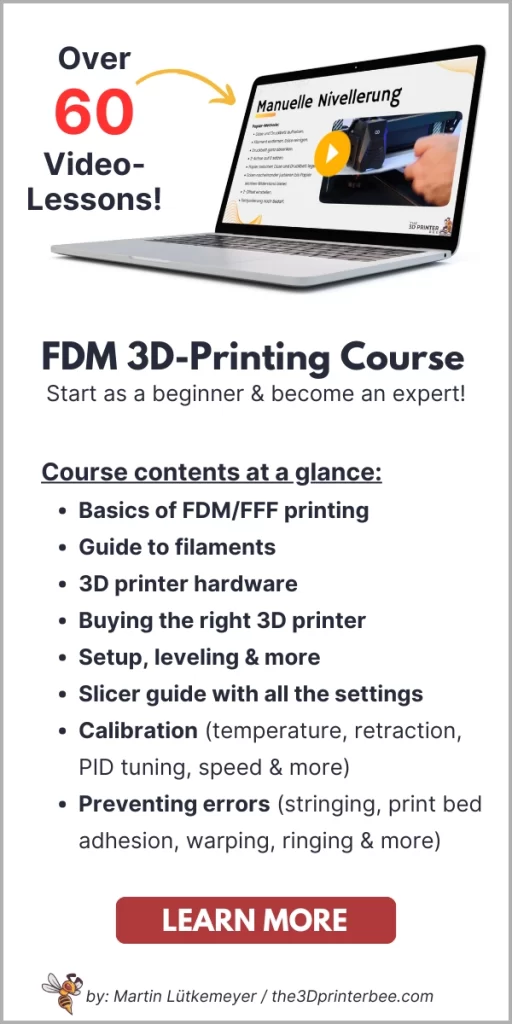- Wet Filament: Prevention, Symptoms & Drying - July 18, 2024
- Sovol SV08 – Best PrusaSlicer Settings & Profile - June 26, 2024
- Sovol SV08 – Best Orca Slicer Settings & Profile - June 26, 2024
Disclosure: Links marked with * are Affiliate Links. I earn from qualifying purchases if you decide to make a purchase through these links – at no additional cost for you!
PETG filament is a great option for 3D printing, but there are a few things you need to watch out for if you want to use it outdoors.
PETG filament is UV resistant and very suitable for outdoor use. It does not warp, does not crack in the sun and does not become brittle in cold weather.
In this article, we’ll go over these and other factors you need to consider when using PETG filament outdoors. We’ll also give you some tips on how to best protect your prints from the elements. At the end, you’ll find the best PETG filaments for outdoor use.
Table of Contents:
Requirements for Filaments for Outdoor Use

PETG filament is weather-resistant and durable, making it perfect for outdoor use. However, there are a few things to keep in mind when using PETG outdoors:
- Use only high quality PETG filament suitable for outdoor use (see below for recommendations).
- Check the finished project regularly for signs of wear or weathering. If you’ve done everything right, there should be no such signs for a very long time.
These properties for filaments for outdoor use are instrumental in their longevity:
- Weatherproof
- UV resistance
- Strength

If you want to know more about PETG, check out the full guide:
PETG Filament Guide | Settings, Adhesion, Stringing & More
Is PETG Weatherproof?
PETG filament is weatherproof and can be used outdoors. It’s perfect for applications where parts need to be strong and durable, but also able to withstand the elements.
Since the glass transition temperature (the temperature above which plastic can be deformed) is around 80-90 °C, PETG can be used in areas that are strongly heated by the sun. This means that it does not deform under the influence of the sun.
PETG filament is also food safe and poses no danger to wildlife. The filament is non-toxic and environmentally friendly, which makes it the perfect material for printing outdoor products. So you don’t have to worry about mice, birds or other animals in your garden being poisoned by your printed object.
This filament can last long outdoors when used for the right applications. It is perfect for making strong and durable parts. So it is also ideal for objects that have not only decorative uses, PETG is also suitable for moving parts or tools.
PETG is also chemical resistant and therefore a good choice for applications where the parts are exposed to aggressive chemicals or solvents. While this is less the case outdoors, it shows how robust this material is. Plus, you can also be sure that it won’t decompose over time and end up in the ground.
Is PETG UV Resistant?
PETG is tough, durable and UV resistant, which makes it ideal for outdoor use. It will not become brittle under sunlight and will not deform even after years of use.
With PETG filament, you can make a variety of objects, from flower pots to birdhouses. And because PETG is so easy to work with, you can create complex designs that wouldn’t be possible with other materials.
However, it is important to note that while PETG does not become brittle from sunlight, colors can slowly fade over months or years. However, this is highly dependent on the individual filament and the pigments used for the colors. The good news is that this discoloration is usually only superficial and can be easily remedied with a little sanding and/or varnishing.
One way to protect PETG filament (or the color of the filament) from UV radiation is to apply a UV-resistant varnish*. This creates a barrier against UV rays and can extend the life of the filament. There are a variety of different UV-resistant varnishes on the market, so be sure to choose one that is compatible with PETG filaments. With a little care, you can ensure that your PETG filament will remain in good condition for many years.
If you don’t care about the color, you have absolutely no need to worry about your PETG filament printed object in the sun.
How Strong is PETG?
PETG is a 3D printing filament known for its strength and durability. In fact, PETG is one of the strongest filaments available on the market today. PETG filament is made from a PET (polyethylene terephthalate) copolymer, which gives it greater strength and flexibility.
PETG is also chemical, UV and heat resistant, making it an ideal choice for applications where other filaments would fail (such as outdoors). With all these advantages, it’s no wonder PETG has become one of the most popular materials for 3D printing.
Is PETG Waterproof?
PETG is waterproof, making it perfect for making outdoor planters or signs.
PETG filament is a good choice for anyone who wants to print objects that come into contact with water or other liquids. Unlike PLA, PETG is not water soluble, meaning it will not dissolve if it gets wet. PETG also warps less easily than ABS, making it a good choice for larger prints.
PETG filament can be used outdoors without fear of it breaking in the rain. However, PETG prints are more difficult to sand and polish than PLA prints, which you should consider when choosing the material for your project.
Print Settings for PETG for Outdoor Use
ABS is also often used for outdoor applications. However, this filament is more difficult to print than PETG due to its properties. So if you don’t have a 3D printer that can print ABS (the print volume of the printer should have an enclosure), PETG is an excellent choice for outdoor use and is easy to print.
When printing with filaments for outdoor use, it is important to choose print settings that make the object stronger and increase layer adhesion.
How to choose the right print settings for PETG for outdoor use:
- Print temperature at the upper range of the temperature range
- Clean nozzle
- Slow print speed
- Small layer thickness
- High line width
- Use only dry filament for printing
All these measures help to increase the adhesion between the individual layers. This makes the object stronger and will last longer outdoors. If you have printed such a robust object, even a strong storm that throws the object through your garden will not be able to destroy it.
When printing with PETG, stringing can often occur or the print bed adhesion is suboptimal. For both of these problems there are simple solutions, which you can find in the following articles:
- PETG Stringing | Main Causes and Best Solutions
- PETG 3D Print Does Not Stick to the Bed? – Try This!
Coatings of PETG for Outdoor Use
If you want to further protect your PETG filament object, there are several ways to coat PETG filament to protect it from the elements. PETG filament is known for being strong and durable. However, PETG can be susceptible to scratches if not properly coated.
A simple coating of PETG filament will protect it from scratches and keep it looking like new. There are several ways to coat PETG filament, but the most popular method is to use clear nail polish or clear spray paint. When the PETG is coated, it is less susceptible to scratches and looks shiny and new.
A popular option is also to spray the filament with a clear acrylic sealant. This creates a barrier between the filament and the outside world, extending the life of your prints.
If you’re looking for something even more durable, you can try powder coating the filament. This is a popular option for metal filament, but can also be used for PETG. Powder coating creates a thick, durable layer that protects your prints from scratches and damage.
There are also special varnishes that are UV resistant*. With this, you can preserve the color of the object for a long time.
Best PETG Filaments for Outdoor Use
Not all PETG filaments are equally suitable for outdoor use. Even if it is the same type of filament, there are big differences between the individual manufacturers in terms of quality, processability and durability outdoors. In the following, 3 filaments are presented that have proven themselves for outdoor use.
ERYONE PETG 3D Printer Filament
Eryone PETG 3D printer filament* is a professional 3D printing material made of high-quality polyethylene terephthalate glycol-modified (PETG) plastic. It has a diameter of 1.75 +/- 0.03 mm, making it perfect for most 3D printers.
It is very suitable for outdoor use. It is UV resistant, so your prints will not fade in the sun. Eryone PETG is also very shock resistant, meaning it can withstand bumps and knocks without breaking. Eryone PETG filament is available in a wide range of colors, so you can find the perfect color for your project. It’s also easy to work with and has very low odor.
I myself have often used this filament for mechanical objects, because it is very robust and withstands mechanical forces well. This is also advantageous for objects that are to be used outdoors, as there are also increased requirements here.
As with most other PETG filaments, you need to make sure that you calibrate the print temperature of the Eryone filament carefully. You may have to spend a little longer perfecting your print settings, but you will be rewarded with extremely high stability and durability which is ideal for outdoor use.
GEEETECH PETG 3D Printer Filament
The GEEETECH PETG filament* is perfect for outdoor use because it is UV resistant. It is also very strong, making it great for tough prints. It is also very popular among DIY hobbyists because it is easy to print and it works well for tools or moving mechanisms.
The filament is a good choice for outdoor 3D printing of objects. It is biodegradable and environmentally friendly, making it a good choice for those looking for an eco-friendly option. PETG is also UV resistant, which means it won’t lose its shape and mechanical stability from the sun’s UV rays.
GEEETECH PETG filament is a durable, user-friendly alternative to ABS filament. This PETG is compatible with all FDM 3D printers and does not require a heated print bed. It is as durable and robust as ABS, making it the ideal choice for 3D printing outdoor objects.
It’s available in a variety of colors, so you can easily find the perfect color for your project. It’s also an affordable alternative to ABS filament, making it a good choice for budget-conscious consumers.
TECBEARS PETG 3D Printer Filament
TECBEARS PETG 3D Printer Filament* is made from 100% environmentally friendly materials and has low shrinkage, making it an ideal choice for high-resolution printing. It is also neatly wound on a spool and has a tolerance of +/- 0.02mm, ensuring consistent print quality every time.
This PETG filament is one of the best for outdoor use as it can withstand extreme weather conditions and is UV resistant. For those looking for a reliable and durable PETG filament, TECBEARS is the perfect choice. TECBEARS PETG filament is extremely durable and can even be put in the dishwasher.
One disadvantage of this filament is that there are sometimes quality differences between batches. I haven’t had any problems with this myself, but sometimes it is reported that the layer adhesion needs some experimentation and stringing can occur frequently. So if you decide to use this filament, be sure to calibrate the extrusion carefully before printing a large object with it.
Conclusion
When it comes to outdoor use, PETG is the ideal choice due to its strength and durability. PETG can withstand high temperatures and UV radiation without degrading, making it perfect for applications in hot climates. In addition, PETG is water-resistant, so it can be used in damp or wet environments without fear of degradation.
If you’re looking for a 3D printing filament that can withstand the elements, PETG is a great choice. PETG’s strength and resistance to heat, UV light, and water make it perfect for outdoor applications. So if you need a durable filament for your next outdoor project, be sure to check out PETG!
Disclosure: This website is the property of Martin Lütkemeyer and is operated by Martin Lütkemeyer. Martin Lütkemeyer is a member of the Amazon Services LLC and other Affiliate Programs. These are affiliate advertising programs designed to enable websites to earn advertising revenue through advertising and linking to Amazon.com and others. Links marked with * are affiliate links.

